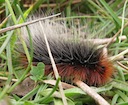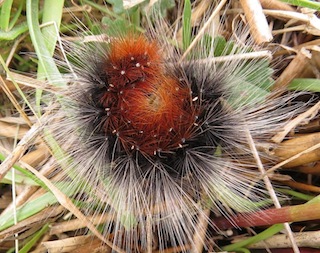 Garden Tiger caterpillars are known as Woolly Bears, for obvious reasons.
Garden Tiger caterpillars are known as Woolly Bears, for obvious reasons.
Photo: Steve Townsend
Scientific name: Arctia caja
Cornish name: ‘Gouwan’ is the general word for moth
Other common names: Great Tiger Moth. The larva is generally known as the Woolly Bear caterpillar.
Conservation status: Priority species in UK Biodiversity Action Plan
What to look for:
- Colouring: Adults are fairly easy to identify, with dark brown and white forewings and orange underwings with blue-ish black spots. There is however much variability in this species. The larvae are very hairy, mainly black and orange with long white hairs.
- Size: Wingspan, 4.5 to 6.5 cm.
- Where: Open habitats, including gardens, parks, or open scrub and woodland.
- When: Caterpillars from August to June. Adults on the wing July and August. The adults are nocturnal.
- Similar species: Other Tiger moth species
This is not a moth to mess with. As an adult, it will flash its orange, blue-black spotted underwings when disturbed. It can also spray a nasty yellow fluid from a couple of ducts behind its head. In fact, the whole moth is far from being a tasty treat, a fact advertised to potential predators by its conspicuous colouring.
The larva looks like a cuddly furry caterpillar, with long hairs that make you want to stroke it. Definitely do not do that! Although not poisonous, the protective hairs will irritate your skin. It is however fun to watch the caterpillar, famously known as the Woolly Bear (for obvious reasons), as it scuttles surprisingly quickly through the undergrowth, or lays basking in the sunshine.
 The caterpillars emerge in August and overwinter as small larvae. They re-emerge the following spring and feed up on low growing vegetation, before pupating through June and July. Adults are on the wing in July and August – they are nocturnal, but are attracted to light.
The caterpillars emerge in August and overwinter as small larvae. They re-emerge the following spring and feed up on low growing vegetation, before pupating through June and July. Adults are on the wing in July and August – they are nocturnal, but are attracted to light.
The Garden Tiger is a moth that is suffering from a severe species decline. Numbers fell by 89% between 1968 and 2002. One of the reasons appears to be the changing climate. The overwintering larvae are adapted to managing cold weather, and do not cope well with the more recent milder winter temperatures. Another issue is possibly habitat change, especially as areas of scrub and weeds, a favourite habitat for this moth, are sprayed and generally tidied.
Did you know…?
…The Garden Tiger’s spectacular colouring made it popular with early Lepidoptera collectors.
More information and references:
Chinery, M., 2005. Collins Complete Guide to British Insects. Collins, London.
Waring, P., Townsend, M. and Lewington, R., 2009. Field Guide to the Moths of Great Britain and Ireland (second edition). British Wildlife Publishing, Gillingham, Dorset.

Published: July 2015
Author: Amanda Scott
Photos: Caterpillar images (Steve Townsend); adult moth (By Temple of Mara (Own work) [CC BY-SA 3.0], via Wikimedia Commons)
